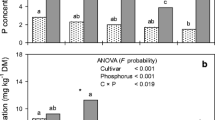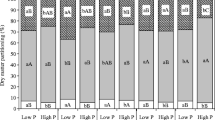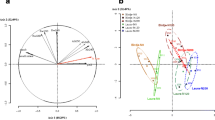Abstract
Seasonal experiments, spring studies in 2008 and 2014, and autumn studies in 2008 and 2013, were conducted to investigate the nutritional and structural response of potato leaves to reduced nitrogen (N) supply in the nutrient solution. Tissue culture plantlets of cultivars Atlantic and Superior were transplanted into a recirculating aeroponic system and grown at N concentration of 7.2 meq L−1 (6.5 meq L−1 NO3–N and 0.7 meq L−1 NH4–N). The N concentration was reduced to 3.5 meq L−1 for 4, 8, and 16 days at 30 days after transplanting (DAT), and compared with control plants which were grown under a constant concentration (7.2 meq L−1) of N. Plants that underwent reduced N brought back to normal N concentration of 7.2 meq L−1. Potato shoots grown under reduced N supply exhibited suppression of total N, calcium (Ca) and magnesium (Mg) uptake, and enhancement of phosphorus (P) uptake. The suppression of N uptake decreased shoot growth and leaf mesophyll development with inhibited chlorophyll accumulation. Photosynthesis decreased significantly with 16 days of N reduction in two seasons in 2008, but did not differ in 2013 and 2014. During spring, days to tuberization for Atlantic were shorter with the reduced N supply, whereas no difference was observed in autumn. Tuberization of Superior was delayed for two days in plants grown for 16 days with a reduced N supply. Although the number and weight of tubers harvested were significantly different in only one of the four experimental seasons, these values appeared to decline with 16 days of N reduction. The cultivar Atlantic was more susceptible to N reduction because differences in nutrient uptake, chlorophyll synthesis, tuberization, and tuber growth in response to N reduction were greater than in Superior. Response to the N reduction was greater in spring than autumn. The data indicated that careful control of N concentration is necessary to minimize possible decrease in tuberization and tuber growth, especially for the cultivar Atlantic and during the spring season.
Resumen
Se condujeron experimentos estacionales, estudios en la primavera de 2008 y 2014, y en el otoño en 2008 y 2013, para investigar la respuesta nutricional y estructural de hojas de papa con suministro reducido de nitrógeno (N) en la solución nutritiva. Se trasplantaron plántulas de cultivo de tejidos de las variedades Atlantic y Superior a un sistema de recirculación aeropónica y se cultivaron a una concentración de N de 7.2 meq L−1 (6.5 meq L−1 NO3-N y 0.7 meq L−1 NH4-N). Se redujo la concentración de N a 3.5 meq L−1 por 4, 8 y 16 días a los 30 días después del trasplante (DAT), y se compararon con plantas testigo que se cultivaron bajo una concentración constante (7.2 meq L−1) de N. Las plantas expuestas a N reducido regresaron a la concentración normal de 7.2 meq L−1. Los tallos de las papas cultivados en un suministro reducido de N exhibieron supresión total de absorción de N, calcio (Ca), y magnesio (Mg), y aumento en la absorción de fosforo (P). La supresión en la absorción del N disminuyó el crecimiento del tallo y el desarrollo del mesófilo foliar, con inhibición en la acumulación de clorofila. La fotosíntesis disminuyó significativamente con 16 días de reducción de N en las dos temporadas en 2008, pero no difirió en 2013 y 2014. Durante la primavera, los días a tuberización para Atlantic fueron más cortos con la reducción del suministro de N, mientras que no se observó diferencia en otoño. La tuberización de Superior se retrasó en dos días en plantas que crecieron por 16 días con suministro reducido de N. Aun cuando el número y peso de tubérculos cosechados fue significativamente diferente en una de las cuatro temporadas experimentales, estos valores parecieron declinar con 16 días de reducción de N. La variedad Atlantic fue más susceptible a la reducción de N porque las diferencias en la absorción de nutrientes, la síntesis de clorofila, la tuberización, y el crecimiento del tubérculo en respuesta a la reducción del N fueron mayores que en Superior. La respuesta a la reducción de N fue más grande en la primavera que en el otoño. Los datos indicaron que el control cuidadoso de la concentración de N es necesario para minimizar la posible disminución en tuberización y crecimiento de tubérculo, especialmente para la variedad Atlantic y durante el ciclo de primavera.




Similar content being viewed by others
References
Barry, C. 1996. Nutrients: The handbook to hydroponic nutrient solutions, 12–39. Australia: Casper.
Benoit, F. 1992. Practical guide for simple soilless culture techniques, 28–29. Belgium: European Vegetable R&D Center.
Cao, W., and T.W. Tibbitts. 1998. Response of potatoes to nitrogen concentrations differ with nitrogen forms. Journal of Plant Nutrition 21: 615–623.
Chang, S.C. 1973. Compounding of Luft’s epon embedding medium for use in electron microscopy with reference to anhydride: Epoxide ratio adjustment. Mikroskopie 29: 337–342.
Chang, D.C., S.Y. Kim, K.Y. Shin, Y.R. Cho, and Y.B. Lee. 2000. Development of a nutrient solution for potato (Solanum tuberosum L.) seed tuber production in a closed hydroponic system. Korean Journal of Horticultural Science & Technology 18: 334–341.
Chang, D.C., C.S. Park, J.G. Lee, J.H. Lee, J.M. Son, and Y.B. Lee. 2005. Optimizing electrical conductivity and pH of nutrient solution for hydroponic culture of seed potatoes (Solanum tuberosum). Journal of the Korean Society for Horticultural Science 46: 26–32.
Chang, D.C., C.S. Park, S.Y. Kim, S.J. Kim, and Y.B. Lee. 2008. Physiological growth responses by nutrient interruption in aeroponically grown potatoes. American Journal of Potato Research 85: 315–323.
Chang, D.C., I.C. Cho, J.T. Suh, S.J. Kim, and Y.B. Lee. 2011. Growth and yield response of three aeroponically grown potato cultivars (Solanum tuberosum L.) to different electrical conductivities of nutrient solution. American Journal of Potato Research 88: 450–458.
Chang, D.C., C.S. Park, S.Y. Kim, and Y.B. Lee. 2012. Growth and Tuberization of hydroponically grown potatoes. Potato Research 55: 69–81.
Chang, D.C., H.B. Sohn, J.H. Cho, J.S. Im, Y.I. Jin, G.R. Do, S.J. Kim, H.M. Cho, and Y.B. Lee. 2014. Freezing and Frost Damage of Potato Plants: a Case Study on Growth Recovery, Yield Response, and Quality Changes. Potato Research 57: 99–110.
Dorange, G., and M.L. Pennec. 1989. Ultrastructural characteristics of spermatogenesis in Pecten maximus (Mollusca: Bivalvia). Invert Reprod Dev 15: 109–117.
Ewing, E.E., and P.C. Struik. 1992. Tuber formation in potato: induction, initiation, and growth. Horticultural Reviews 14: 89–198.
Farran, I., and A.M. Mingo-Castel. 2006. Potato minituber production using aeroponics: effect of plant density and harvesting intervals. American Journal of Potato Research 86: 47–53.
Fidalgo, F., I. Santos, and R. Salema. 1993. Effects of deltamethrin on field grown potato plants: biochemical and ultrastructural aspects. Annals of Botany 72: 263–267.
Gardner, F.P., R.B. Pearce, and R.L. Mitchell. 1985. Physiology of crop plants, 102–104. Ames, Iowa, USA: Iowa State Univ.
Geary, B., J. Clark, B.G. Hopkins, and V.D. Jolley. 2015. Deficient, adequate and excess nitrogen levels established in hydroponics for biotic and abiotic stress-interaction studies in potato. Journal of Plant Nutrition 38: 41–50.
Goins, G.D., N.C. Yorio, and R.M. Wheeler. 2004. Influence of nitrogen nutrition management on biomass partitioning and nitrogen use efficiency indices in hydroponically grown potato. Journal of the American Society of Horticultural Science 129: 134–140.
Greksak, M., T. Asahi, and I. Uritani. 1972. Increase in mitochondrial activity in diseased sweet potato root tissue. Plant and Cell Physiology 13: 1117–1121.
Hopkins, B.G., D.A. Horneck, M.J. Pavek, B.D. Geary, N.L. Olsen, J.W. Ellsworth, G.D. Newberry, J.S. Miller, R.E. Thornton, and G.W. Harding. 2007. Evaluation of potato production best management practices. American Journal of Potato Research 84: 19–27.
Ishikawa, E., S.K. Bae, O. Miyawaki, K. Nakamura, Y. Shiinoki, and K. Ito. 1997. Freezing injury of cultured rice cells analyzed by dielectric measurement. Journal of Fermentation and Bioengineering 83: 222–226.
Joern, B.C., and M.L. Vitosh. 1995. Influence of applied nitrogen on potato. Part 1: Yield, quality, and nitrogen uptake. American Potato Journal 72: 51–63.
Kang, J.G., S.Y. Kim, H.J. Kim, Y.H. Om, and J.K. Kim. 1996a. Growth and tuberization of potato (Solanum tuberosum L.) cultivars in aeroponics, deep flow technique and nutrient film technique culture systems (in Korean). Journal of the Korean Society for Horticultural Science 37: 24–27.
Kang, J.G., S.Y. Yang, and S.Y. Kim. 1996b. Effects of nitrogen levels on the plant growth, tuberization and quality of potatoes grown in aeroponics (in Korean). Journal of the Korean Society for Horticultural Science 37: 761–766.
Kleinkopf, G.E., D.T. Westermann, and R.B. Dwelle. 1981. Dry matter production and nitrogen utilization by six potato cultivars. Agronomy Journal 73: 799–802.
Krauss, A., and H. Marschner. 1982. Influence of nitrogen nutrition, daylength and temperature on contents of gibberellic and abscisic acid and on tuberization in potato plants. Potato Research 25: 13–21.
Lim, W.K., and D.B. Im. 1984. Experimental botany, 137–144. Seoul, Korea: Ilsinsa.
Lin, S., B. Sattelmacher, E. Kutzmutz, K.H. Muhling, and K. Dittert. 2004. Influence of nitrogen nutrition on tuber quality of potato with special reference to the pathway of nitrate transport into tubers. Journal of Plant Nutrition 27: 341–350.
Love, S.L., J.C. Stark, and T. Salaiz. 2005. Response of four potato cultivars to rate and timing of nitrogen fertilizer. American Journal of Potato Research 82: 21–30.
Lutts, S., M. Almansouri, and J.M. Kinet. 2004. Salinity and water stress have contrasting effects on the relationship between growth and cell viability during and after stress exposure in durum wheat callus. Plant Science 167: 9–18.
Marschner, H. 1995. Mineral nutrition of higher plants. In 2nd ed, 167–169, 235–243. San Diego: Academic Press Inc.
Millard, P., and B. Marshall. 1986. Growth, nitrogen uptake and partitioning within the potato (Solanum tuberosum L.) crop, in relation to nitrogen application. Journal Agricultural Science Cambridge 107: 421–429.
Miller, J.S., and B.G. Hopkins. 2007. Checklist for a holistic potato health management plan. In potato health management, ed. D.A. Johnson, 7–10. Minneapolis, MN: American Phytopathological Society.
Neubauer, W., and G. Pienz. 1993. The nitrate content of potatoes. Results of field trials on environmentally responsible farming practices. Agribiological Research 46: 120–125.
Oraby, H., A. Lachance, and Y. Desjardins. 2015. A low nutrient solution temperature and the application of stress treatments increase potato mini-tuber production in an aeroponic system. American Journal of Potato Research 92: 387–397.
Ritter, E., B. Angulo, P. Riga, C. Herran, J. Relloso, and M. San Jose. 2001. Comparison of hydroponic and aeroponic cultivation systems for the production of potato minitubers. Potato Research 44: 127–135.
Roberts, S., W.H. Weaver, and J.P. Phelps. 1982. Effect of rate and time of fertilization on nitrogen and yield of Russet Burbank potatoes under center pivot irrigation. American Potato Journal 59: 77–86.
Romer, J. 1993. Hydroponic crop production, 9–18. In Maryborough, Vic. 3465. Australia: Kangaroo Press Pty Ltd.
Ross, J. 1998. Hydroponic tomato production: a practical guide to growing tomatoes in containers, 46–80. In Narrabeen, NSW 2101. Australia: Casper publications Pty Ltd.
Sonneveld, C. 1993. An overview of nutrition in hydroponics. In Hydroponics and the environment, ed. B. Laffer, 21–36. Melbourne, Australia: Monash Univ.
Stern, K.R. 1994. Introductory plant biology. In 91–100, 144–153. Dubuque, Iowa: Wm. C. Brown Publishers.
Tierno, R., A. Carrasco, E. Ritter, and J.I.R. Galarreta. 2014. Differential growth response and minituber production of three potato cultivars under aeroponics and greenhouse bed culture. American Journal of Potato Research 91: 346–353.
Vos, J., and H. Biemond. 1992. Effects of nitrogen on the development and growth of the potato plant. 1. Leaf appearance, expansion growth, life spans of leaves and stem branching. Annals of Botany 70: 27–35.
Vos, J., and van der Putten. 1998. Effect of nitrogen supply on leaf growth, leaf nitrogen economy and photosynthetic capacity in potato. Field Crops Research 59: 63–72.
Acknowledgments
This work was carried out with the support of Cooperative Research Program for Agriculture Science & Technology Development (PJ01024004 and PJ00993603) Rural Development Administration (RDA), Republic of Korea. We thank Gyeong Ran Do, National Institute of Horticultural and Herbal Science, for help in taking micrograph and Hye Rim Lee, RDA, for statistical analysis.
Author information
Authors and Affiliations
Corresponding author
Rights and permissions
About this article
Cite this article
Chang, D.C., Jin, Y.I., Kim, S.J. et al. Nutritional and Structural Response of Potato Plants to Reduced Nitrogen Supply in Nutrient Solution. Am. J. Potato Res. 93, 368–377 (2016). https://doi.org/10.1007/s12230-016-9510-z
Published:
Issue Date:
DOI: https://doi.org/10.1007/s12230-016-9510-z




